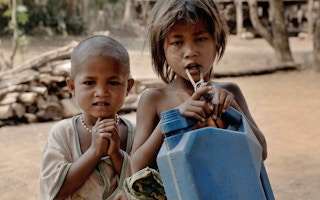Large numbers of children remain malnourished in Laos, especially in poorer rural parts of the country, despite efforts by the UN World Food Programme and other concerned organisations to provide better food, sources in Laos say.
Though numbers have improved slightly in recent years, the problem persists and is especially severe in remote areas near the border with Vietnam not easily accessed by vehicles or aid workers, sources say.
Speaking this week to RFA’s Lao Service, a health department official in Salavan province, in the southern part of the country, said that rates of malnourishment leading to stunted growth in children in the province remain high.
“Our province still has high rates for malnourished, stunted, and underweight children, because up to 60 per cent of our children have not eaten good food from the time they were in their mothers’ womb,” RFA’s source said, speaking on condition of anonymity.
In areas more easily reached, the numbers are not so high, because children receive food aid from free lunch programs offered by the UN World Food Programme, the source said, adding that the program provides rice soup fortified with vitamins and minerals to children, along with “supplementary” food offered to pregnant women.
In Sekong province, also in the south, the rate of malnourished children now stands at 49.9 per cent, an official from the province’s department for mothers and children told RFA.
“This is still high compared with the national average, which is 33 per cent,” the official said, also speaking on condition he not be named.
“The rate is still high because people here are very poor and uneducated,” he said, adding that in Sekong’s Dak Jeung and Kaleum districts near the border with Vietnam, the rate is even higher, because mothers feed their children only with rice from the age of three months.
Targets not met
High rates meanwhile also persist in the country’s far north, with Phongsaly province—one of the seven poorest provinces in Laos, along with Sekong, Salavan, Attapeu, Xieng Khouang, Oudomxay, and Xaysomboun—showing numbers only slightly down from a high three years ago of 50 per cent, a provincial health department official said.
“The health ministry required us to reduce the rate of stunting from 50 per cent three years ago to 32 per cent last year, but we could reduce the rate only to 44.5 per cent,” he said, adding, “We failed to achieve our targets.”
Though most villagers in the province have access to vegetables, fruits, meat, and fish, most children and their parents eat only rice, the official said.
Meanwhile, in Xieng Khouang province in the country’s northeast, of 4,000 children under the age of five treated last year in the provincial hospital, 35 per cent were found to be stunted from lack of nutrition, while in Attapeu province in southeast Laos, up to 50 per cent of children displaced last year by a dam collapse have been found to be malnourished and underweight.
“And this was not because of the dam collapse,” a health department official in Attapeu told RFA early in February. “They were malnourished long before that.”
Speaking this week to RFA, a doctor from Savannakhet province attending a conference in the capital Vientiane said that the national rate for stunted children in Laos now stands at 33 per cent, with the rate in Savannakhet itself, one of the wealthiest provinces in the country, reported at 27 per cent.
The UN’s World Food Programme now runs a programme providing supplemental food to children for up to a thousand days in the country’s seven poorest provinces, a Lao health official told RFA in February. But the programme is set to end in 2021, and he hopes the country can keep the programme running beyond that date, he said.
Copyright © 1998-2019, RFA. Used with the permission of Radio Free Asia, 2025 M St. NW, Suite 300, Washington DC 20036.








